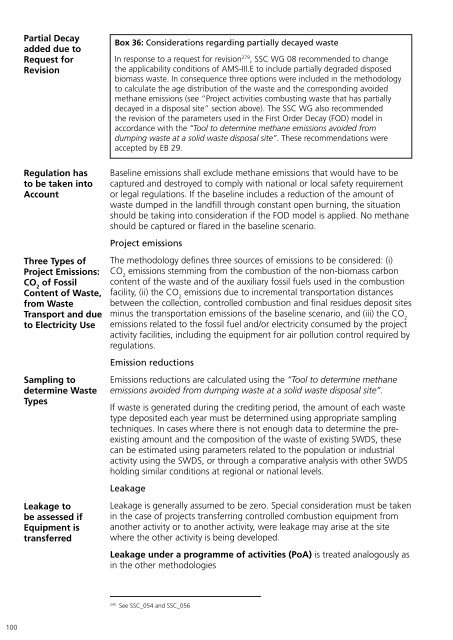Understanding CDM Methodologies - SuSanA
Understanding CDM Methodologies - SuSanA
Understanding CDM Methodologies - SuSanA
You also want an ePaper? Increase the reach of your titles
YUMPU automatically turns print PDFs into web optimized ePapers that Google loves.
Partial Decay<br />
added due to<br />
Request for<br />
Revision<br />
Box 36: Considerations regarding partially decayed waste<br />
In response to a request for revision 279 , SSC WG 08 recommended to change<br />
the applicability conditions of AMS-III.E to include partially degraded disposed<br />
biomass waste. In consequence three options were included in the methodology<br />
to calculate the age distribution of the waste and the corresponding avoided<br />
methane emissions (see “Project activities combusting waste that has partially<br />
decayed in a disposal site” section above). The SSC WG also recommended<br />
the revision of the parameters used in the First Order Decay (FOD) model in<br />
accordance with the “Tool to determine methane emissions avoided from<br />
dumping waste at a solid waste disposal site”. These recommendations were<br />
accepted by EB 29.<br />
Regulation has<br />
to be taken into<br />
Account<br />
245<br />
Baseline emissions shall exclude methane emissions that would have to be<br />
captured and destroyed to comply with national or local safety requirement<br />
or legal regulations. If the baseline includes a reduction of the amount of<br />
waste dumped in the landfill through constant open burning, the situation<br />
should be taking into consideration if the FOD model is applied. No methane<br />
should be captured or flared in the baseline scenario.<br />
Project emissions<br />
Three Types of<br />
Project Emissions:<br />
CO 2<br />
of Fossil<br />
Content of Waste,<br />
from Waste<br />
Transport and due<br />
to Electricity Use<br />
The methodology defines three sources of emissions to be considered: (i)<br />
CO 2<br />
emissions stemming from the combustion of the non-biomass carbon<br />
content of the waste and of the auxiliary fossil fuels used in the combustion<br />
facility, (ii) the CO 2<br />
emissions due to incremental transportation distances<br />
between the collection, controlled combustion and final residues deposit sites<br />
minus the transportation emissions of the baseline scenario, and (iii) the CO 2<br />
emissions related to the fossil fuel and/or electricity consumed by the project<br />
activity facilities, including the equipment for air pollution control required by<br />
regulations.<br />
Emission reductions<br />
Sampling to<br />
determine Waste<br />
Types<br />
Emissions reductions are calculated using the “Tool to determine methane<br />
emissions avoided from dumping waste at a solid waste disposal site”.<br />
If waste is generated during the crediting period, the amount of each waste<br />
type deposited each year must be determined using appropriate sampling<br />
techniques. In cases where there is not enough data to determine the preexisting<br />
amount and the composition of the waste of existing SWDS, these<br />
can be estimated using parameters related to the population or industrial<br />
activity using the SWDS, or through a comparative analysis with other SWDS<br />
holding similar conditions at regional or national levels.<br />
Leakage<br />
Leakage to<br />
be assessed if<br />
Equipment is<br />
transferred<br />
Leakage is generally assumed to be zero. Special consideration must be taken<br />
in the case of projects transferring controlled combustion equipment from<br />
another activity or to another activity, were leakage may arise at the site<br />
where the other activity is being developed.<br />
Leakage under a programme of activities (PoA) is treated analogously as<br />
in the other methodologies<br />
245<br />
See SSC_054 and SSC_056<br />
100

















